Day 63-65, September 17-19, 2008
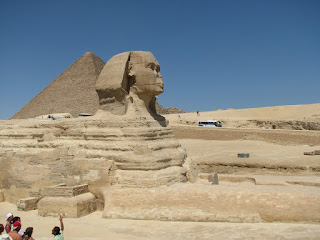
I flew into Egypt yesterday.
My first glimpse of the pyramids was from the air. I was flying in from the east. After my layover in Bahrain, I flew across Saudi Arabia, the Sinai Peninsula, and the Suez and Aquaba Gulfs at the north end of the Red Sea. If I listened to my freshman year high school religion teacher, Sister Joan, I would still believe that Moses crossed the Panama Canal. However, as the bible has it, he crossed with the Hebrews somewhere under where my plane flew over 3000 years ago.
From the turquoise blue of the Red Sea, you cross over the eastern Egyptian desert. It looks like pictures from a Martian Lander. The sand and clay have a faint red tint and the desert stretches as far as the eye can see.
Almost all of Egypt’s population of 80 million lives, as they have for over 5000 years, in the several mile belt of habitable land that hugs the Nile up the entire length of the country. From the air, the boundary between desert and oasis looks like someone drew a sharp line in the sand down on either side of the Nile.
Our airplane crossed the Nile Valley and turned around back west to land. After completing the turn, there they were: the pyramids of Giza towering over everything else in the city. They sit on a patch of desert on the West side of the Nile and almost everything around them has been irrigated to try to reclaim any habitable land from the desert. They look like they are sitting on a sandy little island surrounded by a sea of green. Even from the air, you can get a sense of their size. You can also pick out the Great Pyramid even if all you had as a description was its name. It is noticeably the largest of the three main pyramids there. I visit on Friday and cannot wait.
I was met at the airport by a representative of the tour company, Meena, who helped me through immigration and drove me to my hotel. I had a day and a half in Cairo without any plans before my tour started.
Meena, recommended a few tours that I could do that weren’t included in my package and a few of them sounded great. Today, after I leave this internet café (the best I’ve found on my trip), I am going to visit the pyramids at Saquarra. Saquarra is where pyramid building began. It has the experiments that were built leading up to the monsters that are on the plateau of Giza. If you want to see how pyramids evolved, you start here.
The other tour he recommended was a walking tour of Muslim and Coptic Cairo led by him, of course. I decided to do that tour last night. Meena was the perfect person to lead this tour. Before becoming a tour guide, he worked for an archeological reconstruction company that restored mosques around Cairo. That meant that not only did he know where to go, he also knew everyone at the mosques so we could go places that most people cannot.
We got to see many old, beautiful mosques and even a Coptic Christian church that is over 1600 years old. That’s not old compared to the pyramids but even Rome doesn’t have any functioning churches that old. At one mosque that Meena had worked at, we were able to climb to the top of the minaret which is the highest point in Cairo. It was an incredible view of a beautiful city. With the minarets shooting up all over the town, it looks like a scene out of Arabian Nights.
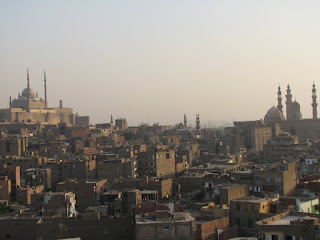
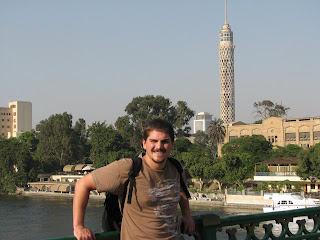
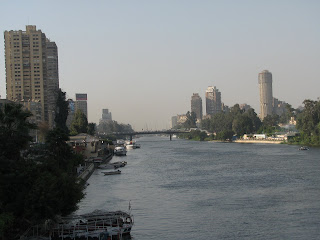
The highlight of the evening was a surprise to me and Meena too, I think. He had asked if I would like to stop by the mosque that the crew he used to work with was restoring. Of course I would. When we got there, they were preparing for a Ramadan feast. Ramadan is the most holy month in Islam and the Muslim’s fast from 5AM to 6PM. We arrived at 5:30 so, needless to say, everyone was ready to eat. During Ramadan, since the evening meal is their first of the day, they call it their breakfast. I’ll talk more about Ramadan later because it has been an incredibly interesting time to visit a Muslim country but for now, just know that I was making friends with about 100 hungry Egyptians.
Meena and I were supposed to go to a restaurant for our dinner but his old boss invited us to stay for their feast. Meena asked me with some trepidation if I wanted to stay, as if he were nervous I wouldn’t enjoy it, but little did he know that is right up my alley. So, my first day in Cairo, I found myself having “breakfast” and celebrating Ramadan with 100 of my new Egyptian friends in a mosque that is over 700 years old. It was awesome. I learned a little Arabic and had an amazing time.


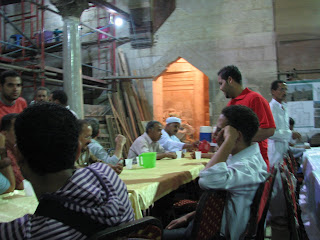
Meena, along with several of the workers at the breakfast, were actually Christians. Meena explained to me that, in Egypt, Christians and Muslims are not only very tolerant of each other but value and support each other. I could tell in Meena’s reverence while describing both the mosques and churches, as well as the local traditions for each religion, that though he was a very devout Christian, he too also had a great respect for Islam.
If you would’ve asked me last week if I’d feel comfortable having a Ramadan meal in an Egyptian mosque with scores of Muslims, I don’t know if I could have honestly answered yes. I feel bad about that now, though, since my hosts could not have been more welcoming or friendly.
I flew into Egypt yesterday.
My first glimpse of the pyramids was from the air. I was flying in from the east. After my layover in Bahrain, I flew across Saudi Arabia, the Sinai Peninsula, and the Suez and Aquaba Gulfs at the north end of the Red Sea. If I listened to my freshman year high school religion teacher, Sister Joan, I would still believe that Moses crossed the Panama Canal. However, as the bible has it, he crossed with the Hebrews somewhere under where my plane flew over 3000 years ago.
From the turquoise blue of the Red Sea, you cross over the eastern Egyptian desert. It looks like pictures from a Martian Lander. The sand and clay have a faint red tint and the desert stretches as far as the eye can see.
Almost all of Egypt’s population of 80 million lives, as they have for over 5000 years, in the several mile belt of habitable land that hugs the Nile up the entire length of the country. From the air, the boundary between desert and oasis looks like someone drew a sharp line in the sand down on either side of the Nile.
Our airplane crossed the Nile Valley and turned around back west to land. After completing the turn, there they were: the pyramids of Giza towering over everything else in the city. They sit on a patch of desert on the West side of the Nile and almost everything around them has been irrigated to try to reclaim any habitable land from the desert. They look like they are sitting on a sandy little island surrounded by a sea of green. Even from the air, you can get a sense of their size. You can also pick out the Great Pyramid even if all you had as a description was its name. It is noticeably the largest of the three main pyramids there. I visit on Friday and cannot wait.
I was met at the airport by a representative of the tour company, Meena, who helped me through immigration and drove me to my hotel. I had a day and a half in Cairo without any plans before my tour started.
Meena, recommended a few tours that I could do that weren’t included in my package and a few of them sounded great. Today, after I leave this internet café (the best I’ve found on my trip), I am going to visit the pyramids at Saquarra. Saquarra is where pyramid building began. It has the experiments that were built leading up to the monsters that are on the plateau of Giza. If you want to see how pyramids evolved, you start here.
The other tour he recommended was a walking tour of Muslim and Coptic Cairo led by him, of course. I decided to do that tour last night. Meena was the perfect person to lead this tour. Before becoming a tour guide, he worked for an archeological reconstruction company that restored mosques around Cairo. That meant that not only did he know where to go, he also knew everyone at the mosques so we could go places that most people cannot.
We got to see many old, beautiful mosques and even a Coptic Christian church that is over 1600 years old. That’s not old compared to the pyramids but even Rome doesn’t have any functioning churches that old. At one mosque that Meena had worked at, we were able to climb to the top of the minaret which is the highest point in Cairo. It was an incredible view of a beautiful city. With the minarets shooting up all over the town, it looks like a scene out of Arabian Nights.
The highlight of the evening was a surprise to me and Meena too, I think. He had asked if I would like to stop by the mosque that the crew he used to work with was restoring. Of course I would. When we got there, they were preparing for a Ramadan feast. Ramadan is the most holy month in Islam and the Muslim’s fast from 5AM to 6PM. We arrived at 5:30 so, needless to say, everyone was ready to eat. During Ramadan, since the evening meal is their first of the day, they call it their breakfast. I’ll talk more about Ramadan later because it has been an incredibly interesting time to visit a Muslim country but for now, just know that I was making friends with about 100 hungry Egyptians.
Meena and I were supposed to go to a restaurant for our dinner but his old boss invited us to stay for their feast. Meena asked me with some trepidation if I wanted to stay, as if he were nervous I wouldn’t enjoy it, but little did he know that is right up my alley. So, my first day in Cairo, I found myself having “breakfast” and celebrating Ramadan with 100 of my new Egyptian friends in a mosque that is over 700 years old. It was awesome. I learned a little Arabic and had an amazing time.
Meena, along with several of the workers at the breakfast, were actually Christians. Meena explained to me that, in Egypt, Christians and Muslims are not only very tolerant of each other but value and support each other. I could tell in Meena’s reverence while describing both the mosques and churches, as well as the local traditions for each religion, that though he was a very devout Christian, he too also had a great respect for Islam.
If you would’ve asked me last week if I’d feel comfortable having a Ramadan meal in an Egyptian mosque with scores of Muslims, I don’t know if I could have honestly answered yes. I feel bad about that now, though, since my hosts could not have been more welcoming or friendly.
------------------------------------------------------------------------------------------
My Ramadan feast was yesterday evening. Today, I took a tour of Memphis, a capitol of ancient Egypt and Saquarra, which I had mentioned earlier as the birthplace of the pyramid.
Memphis was not much to look at. It sits in the Nile Valley and millennia of flooding have taken their toll. They have excavated some amazing artifacts which can be seen in a museum on site but other than that, it was a quick stop.
Saquarra was very interesting. Djosier, a pharaoh that lived about 2600 years BC, built here the first large, stone, pyramid shaped tomb for himself. It is not a true pyramid as compared to the monoliths a few miles away, though, because it is really a series of progressively smaller square building built on top of each other. It also doesn’t have some of the other architectural requirements to be classified as a true pyramid but is impressive nonetheless and served as inspiration for later pharaohs to build theirs.
My Ramadan feast was yesterday evening. Today, I took a tour of Memphis, a capitol of ancient Egypt and Saquarra, which I had mentioned earlier as the birthplace of the pyramid.
Memphis was not much to look at. It sits in the Nile Valley and millennia of flooding have taken their toll. They have excavated some amazing artifacts which can be seen in a museum on site but other than that, it was a quick stop.
Saquarra was very interesting. Djosier, a pharaoh that lived about 2600 years BC, built here the first large, stone, pyramid shaped tomb for himself. It is not a true pyramid as compared to the monoliths a few miles away, though, because it is really a series of progressively smaller square building built on top of each other. It also doesn’t have some of the other architectural requirements to be classified as a true pyramid but is impressive nonetheless and served as inspiration for later pharaohs to build theirs.
Also visible here, in the distance, is the first true pyramid. It is named the red pyramid and was built by a pharaoh named Snefru. Next to it is another of Snefru’s earlier failed pyramids called the Bent Pyramid. The lower half was built with normal proportions but, since pyramid building hadn’t been perfected yet, it couldn’t support its own weight and the angle had to be changed at the top to use less stone and reduce the weight.
Tonight, I meet my tour group with which I will spending the next 17 days. I will pick-up writing after then.
Right now it is Sunday afternoon. I am in Aswan, Egypt and have some time to catch up on as it has been a very packed few days. I’ll start back where I left off on Thursday evening.
That night, I met my tour group. I was a little worried about this because I knew that THE group can make or break any trip. Fortunately, I have a great group. It is diverse, though not as diverse as some groups I have been with, and everyone seems to be fun or at least friendly. That’s a good thing because I will be spending over 2 weeks with them. Actually, I will be spending more time with some of them as several people are going to hop the border into Israel and we have decided to travel together.
There are 15 people in the group plus our leader, Michael. He is a 26 year old Egyptian and so far, has been a great leader. His English and knowledge are excellent. Also, we have a group that can be easily distracted and he has done a great job of keeping us on track. That has been no easy task on his end, I am sure.
In the group, there are:
- A couple from Sweden
- A couple from NY
- A girl from NY
- A girl from Colombia
- Two couples from Canada
- A guy from Melbourne
- Two girls from Canada
- A girl from Oregon
- Me
I have mostly been hanging out with one of the Canadian couples, Brian and Karen; the couple from NY, Brain and Shipra; the girl from NY, Katie; the two Canadian girls, Amanda and Larissa; and the Colombian girl, Maria. That is my extended Egyptian family. Mostly, though, it seems that everyone has broken off into twos for sightseeing and picture taking and the person that I have been hanging out with the most is the Colombian girl, Maria. She is crazy. Maria esta loca!
We all met on Thursday night and our tours started on Friday. That was our Pyramid and Egyptian museum day.
Driving around Cairo, you can get a sense of the beauty and culture of the city but, like most big cities around the world, sanitation is not high on the priority list. On the way to the pyramids, you pass several irrigation canals that come off of the Nile and all are full of trash. One of them even had a bloated dead horse floating in it. I was sitting next to my friend, Maria, on the bus and neither of us could really believe what we had just seen.
The Great Pyramid is beyond words. I don’t know any more that I can say that hasn’t already been said or written about it. It took a crew of 100,000 people over 20 years to complete, consists of over 2 million granite blocks that all weigh over 10 tons and were floated up the Nile from over 500 miles away. It was the tallest manmade structure on Earth for over 4500 years and standing next to it and climbing onto it is something nobody should live their life without experiencing.
While at the pyramid complex, we also took a short camel ride and saw the other pyramids and the Sphinx. That was my first of two camel rides so far and I noticed one consistency: camels stink.
All in all, it was an amazing day. We spent a few hours at the pyramids and it wasn’t near enough. We moved so quickly in order to see everything that there wasn’t really enough time to just sit and appreciate what was in front of me. Next week, we have another day in Cairo and I think that I will have to go back to the pyramids.
The afternoon consisted of a few hours at the Egyptian Museum which houses all of the treasures of Ancient Egypt that haven’t ended up in the U.S, France, or Britain. This museum has over 100,000 pieces on exhibit so it is impossible to see everything but we definitely got the highlights. We saw some of the more famous mummies like Ramses II which is the Pharaoh that is most often associated with Moses and the Exodus. We also saw the King Tut exhibit which takes up most of one floor of the museum. I have never seen so much gold in one place. King Tut was, in reality, a rather insignificant Pharaoh who is famous to us solely because his tomb was the only one, out of scores of Pharaohs, that wasn’t looted in antiquity. From it, we saw how much effort and wealth was put into ensuring the afterlife of a Pharaoh. I’ve also decided that when my time comes, I would also like a 100 pound solid gold mask resting with me. Is that too much to ask?
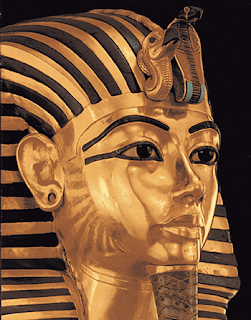 (King Tut picture from the internet)
(King Tut picture from the internet)From here, we proceed via train to the far south of Egypt, about 500 miles up the Nile from Cairo. We’ll be spending a few days there and then making our way via boat, bus, and train back north to Cairo over several days before spending some time at the Red Sea, the Sinai Peninsula, and then crossing into Jordan for the second part of the tour.
No comments:
Post a Comment